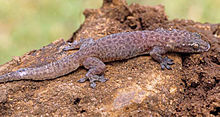
Gehyra mutilata

Gehyra mutilata, also known as the common four-clawed gecko, stump-toed gecko, tender-skinned house gecko, sugar gecko, Pacific gecko, or butiki, is a gecko that is probably native to Southeast Asia, closely related to the common house gecko. It has made its way to several areas of the world including Sri Lanka, Indochina, and many of the Pacific Islands. The gecko is somewhat plump, with delicate skin. The skin is usually colored a soft purplish/pinkish gray with golden spots on younger specimens; these spots eventually fade with age. Head longer than broad; snout longer than distance between eye and ear-opening, about 1.3 times the diameter of the orbit; forehead with a median groove; ear-opening moderately large, suboval. Body and limbs moderately elongate, depressed, a fold of the skin bordering the hind limb posteriorly. Digits short, more or less webbed at the base; the inferior lamellae angular, divided by a median groove. Upper surface and throat covered with small granular scales, largest and flat on the back. Abdominal scales moderate. Rostral quadrangular, broader than deep, with a median cleft above; nostril pierced between the rostral, the first labial, and three nasals, the upper much the largest and generally in contact with its fellow; 8 or 9 upper and 6 or 7 lower labials; mental moderately large, pentagonal; chin-shields 3 pairs, inner very large, elongate, outer small, frequently broken up into small scales. Femoral pores in a doubly curved line, angular in the middle, 14 to 19 on each side. Tail depressed, normally with a sharpish, minutely serrated lateral edge; its upper surface covered with very small flat scales, its lower surface generally with a median series of large transversely dilated scales. Greyish or reddish brown above, uniform or dotted or variegated with darker; lower surfaces uniform whitish.
